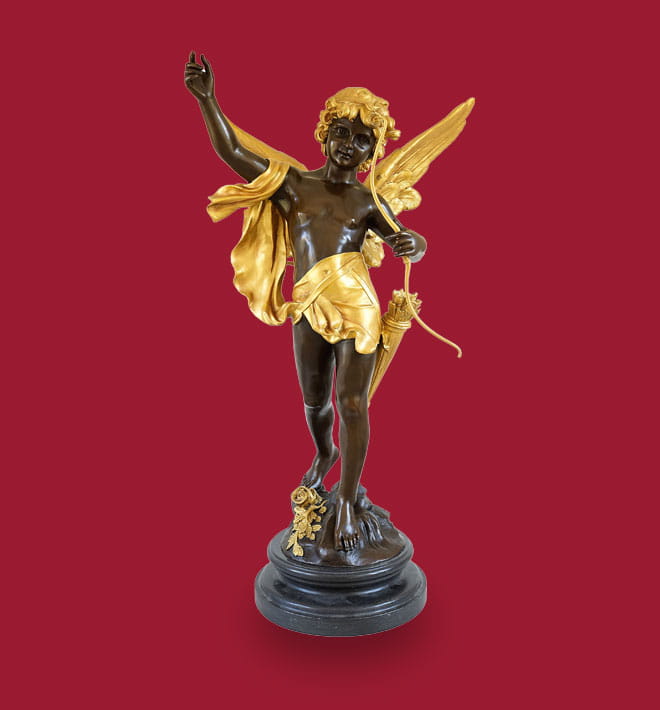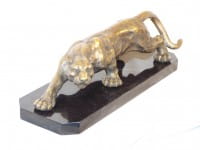€499.00 *
Prices incl. VAT, free shipping worldwide
Ready to ship today,
Delivery time appr. 3-6 workdays










Struggle and Triumph Personified: Freedom for Fight – African Slave – Bergmann Stamp In... more
Product description
"Vienna Bronze - Fight for Freedom - African Slave Statue"
| Weight | 3,1 kg |
Struggle and Triumph Personified: Freedom for Fight – African Slave – Bergmann Stamp
In "Freedom for Fight," Franz Xaver Bergmann captures the moment when despair turns into determination. A young African Slave strains against his shackles. His muscles tense beneath the gleaming bronze skin as he places one foot on the roughly hewn pedestal. His clenched fists, raised to chest height, seem to tear the chains that once held him. Every tendon, every muscle is rendered with Bergmann's uncanny anatomical accuracy, giving the figure an electrifying sense of impending liberation.
Vienna's Bronze Voice of Conscience
Franz Xaver Bergmann was born in Vienna in 1861, the son of a renowned metalworker whose workshop was located in the historic Josefstadt district. Growing up amidst hammers, furnaces, and curious apprentices, the young Franz acquired both craftsmanship and a keen sense of social trends. In the 1890s, he transformed his family's foundry into a melting pot of artistic innovation and became a pioneer of Vienna Bronze—small-scale sculptures full of dramatic expressiveness and moral purpose.
Forged in the Heart of the Habsburg Empire
"Fight for Freedom," modeled in Bergmann's Viennese workshop, began as a dynamic clay study. Bergmann sought to express the universal desire for freedom—a theme that resonated with the political upheavals of his time. After completing the clay version, he entrusted it to skilled casters, who used the lost-wax casting process to capture every weld line and every outburst of emotion on the figure's furrowed brow. The final bronze was then polished and patinated, its dark brown luster emphasizing the play of light and shadow on the slave's tense figure.
Anatomy of Defiance and Hope
Bergmann's decision to leave the figure nearly naked underscores the raw human drama unfolding here. Thongs of coarse cloth envelop his waist and chest—relics of captivity that now serve as a testament to his conquest. His head is tilted upward, his eyes fixed on an invisible horizon, as if challenging the viewer to share his dream of emancipation. From the weathered texture of his sandals to the delicate creases where fabric meets skin, every detail underscores the story of struggle and redemption.
The Bergmann Stamp: Seal of Authenticity
On the base of the sculpture is the discreet "Bergmann" stamp—Franz Xaver Bergmann's signature. This mark not only marks the work's provenance but also its place in a tradition of socially conscious art. Collectors of Viennese bronzes value the Bergmann stamp as a guarantee of both technical mastery and the moral depth that characterizes his works.
A Statement with Lasting Resonance
Presented on a dignified pedestal, "Fight for Freedom" conquers any space with its blend of physical presence and emotional power. In a study filled with historical books, it evokes humanity's long journey toward justice. In a modern gallery, its classical form and contemporary subject matter inspire a dialogue about resilience and human rights. The sculpture's universal message transcends time and space, making it as relevant today as it was over a century ago.
The Legacy of Franz Xaver Bergmann
From his birth in 1861 until his death in 1936, Bergmann dedicated himself to exploring the intersection of art and conscience. His Viennese workshop created countless small bronzes—animals, allegorical figures, and dramatic tableaux—but few speak as clearly of human dignity as "Fight for Freedom." As long as bronze endures, so will this testament to the unquenchable spirit that drives all peoples toward freedom.
In "Freedom for Fight," Franz Xaver Bergmann captures the moment when despair turns into determination. A young African Slave strains against his shackles. His muscles tense beneath the gleaming bronze skin as he places one foot on the roughly hewn pedestal. His clenched fists, raised to chest height, seem to tear the chains that once held him. Every tendon, every muscle is rendered with Bergmann's uncanny anatomical accuracy, giving the figure an electrifying sense of impending liberation.
Vienna's Bronze Voice of Conscience
Franz Xaver Bergmann was born in Vienna in 1861, the son of a renowned metalworker whose workshop was located in the historic Josefstadt district. Growing up amidst hammers, furnaces, and curious apprentices, the young Franz acquired both craftsmanship and a keen sense of social trends. In the 1890s, he transformed his family's foundry into a melting pot of artistic innovation and became a pioneer of Vienna Bronze—small-scale sculptures full of dramatic expressiveness and moral purpose.
Forged in the Heart of the Habsburg Empire
"Fight for Freedom," modeled in Bergmann's Viennese workshop, began as a dynamic clay study. Bergmann sought to express the universal desire for freedom—a theme that resonated with the political upheavals of his time. After completing the clay version, he entrusted it to skilled casters, who used the lost-wax casting process to capture every weld line and every outburst of emotion on the figure's furrowed brow. The final bronze was then polished and patinated, its dark brown luster emphasizing the play of light and shadow on the slave's tense figure.
Anatomy of Defiance and Hope
Bergmann's decision to leave the figure nearly naked underscores the raw human drama unfolding here. Thongs of coarse cloth envelop his waist and chest—relics of captivity that now serve as a testament to his conquest. His head is tilted upward, his eyes fixed on an invisible horizon, as if challenging the viewer to share his dream of emancipation. From the weathered texture of his sandals to the delicate creases where fabric meets skin, every detail underscores the story of struggle and redemption.
The Bergmann Stamp: Seal of Authenticity
On the base of the sculpture is the discreet "Bergmann" stamp—Franz Xaver Bergmann's signature. This mark not only marks the work's provenance but also its place in a tradition of socially conscious art. Collectors of Viennese bronzes value the Bergmann stamp as a guarantee of both technical mastery and the moral depth that characterizes his works.
A Statement with Lasting Resonance
Presented on a dignified pedestal, "Fight for Freedom" conquers any space with its blend of physical presence and emotional power. In a study filled with historical books, it evokes humanity's long journey toward justice. In a modern gallery, its classical form and contemporary subject matter inspire a dialogue about resilience and human rights. The sculpture's universal message transcends time and space, making it as relevant today as it was over a century ago.
The Legacy of Franz Xaver Bergmann
From his birth in 1861 until his death in 1936, Bergmann dedicated himself to exploring the intersection of art and conscience. His Viennese workshop created countless small bronzes—animals, allegorical figures, and dramatic tableaux—but few speak as clearly of human dignity as "Fight for Freedom." As long as bronze endures, so will this testament to the unquenchable spirit that drives all peoples toward freedom.
Height: 29 cm
Width: 19 cm
Depth: 16 cm
Weight: 3,1 kg
100% bronze
Related links to "Vienna Bronze - Fight for Freedom - African Slave Statue"
Read, write and discuss reviews... more
Customer evaluation for "Vienna Bronze - Fight for Freedom - African Slave Statue"
Write an evaluation
Evaluations will be activated after verification.
Our advantages
free shipping
Worldwide free shipping
14 days money back
You can cancel your order
within 14 days
secure payment services
Paypal, Master Card, Visa, American Express and more













































